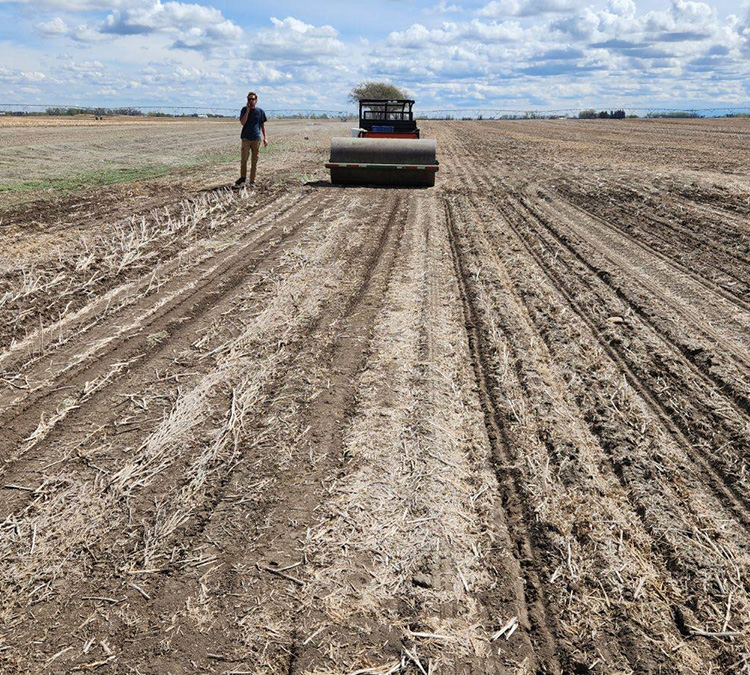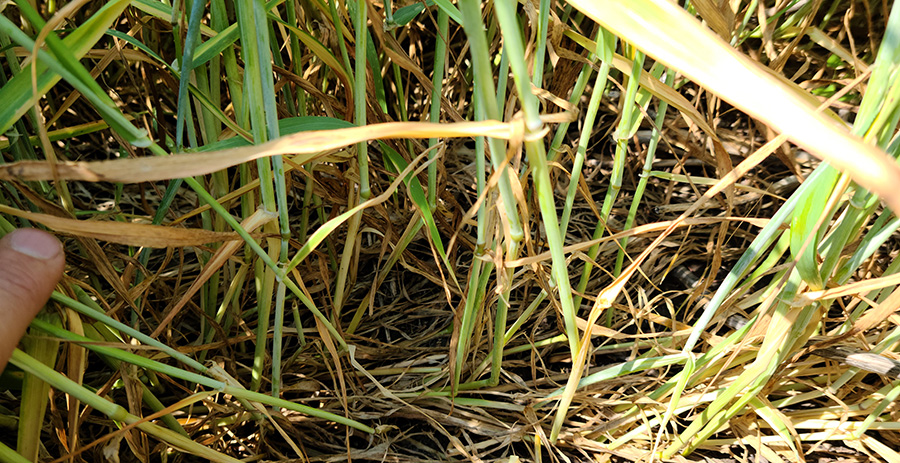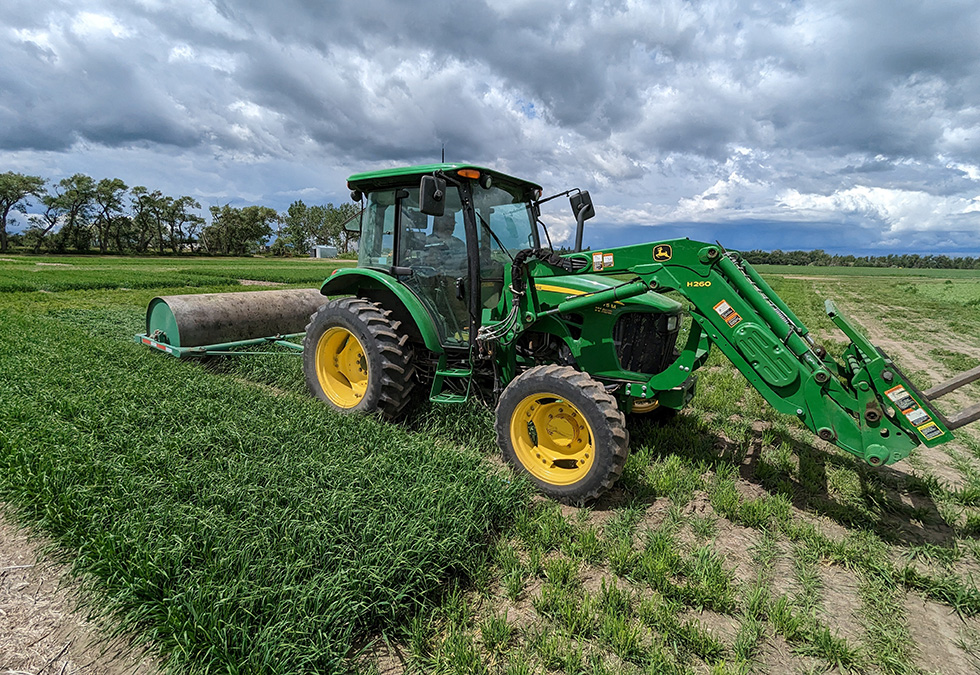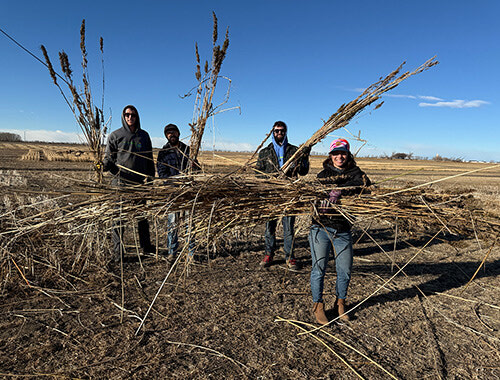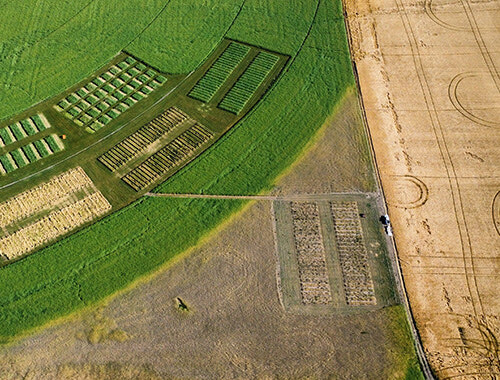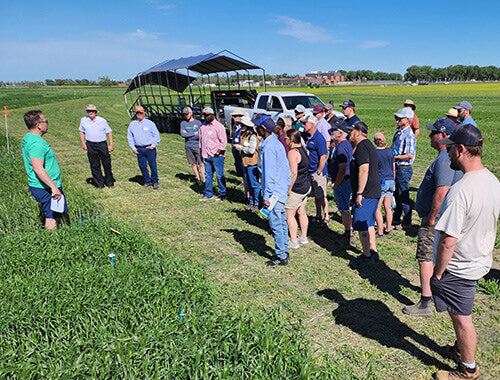By Lee Hart for the Farming Smarter Spring 2024 magazine
After two years of Farming Smarter research trials with a third year to go in 2024, results show if you plan to roll wheat and barley silage crops the optimum time is when the crop is at the two to three leaf stage.
Rolling fields earlier won't necessarily hurt the crop, but for farms exposed to strong spring winds it may leave the soil more vulnerable to wind erosion. And if you leave field rolling until the three to five tiller stage and certainly into the two-node crop stage there is increased risk of yield reduction.
Once technicians analyze the data from summer research trials in late 2024, the project should have a more definite recommendation, says Trevor Deering, Farming Smarter manager of commercial innovation projects. "But from what we saw in the 2022 and 2023 trials, everything points to that two to three leaf stage as the ideal time to roll fields."
The issue at hand is to identify the optimum time to roll fields — level out any ridges, soil clumps and push rocks into the ground — so the silage crop can be efficiently harvested. But it involves finding that sweet spot between rolling too early, which can increase the risk of soil wind erosion and rolling late, which increases the risk of reducing both grain and biomass yield.
"Our various trials over the years involved plots of irrigated wheat and barley silage crops seeded under conventional tillage as well as zero-till cropping systems," says Deering. "In this part of Alberta, strong winds in early spring can lead to soil erosion. Many farmers like to leave fields a bit rough after seeding, as stubble, and soil ridges help protect soil until the crop gets up and growing. But on the other end forage harvesters, many of them being custom silage operators, want fields as level as possible so their harvester headers aren't damaged by rocks and soil during the cutting operation."
|
|
|
Rolling a cereal plot immediately following seeding. |
Southern Alberta crop consultant George Lubberts, owner of Complete Agronomic Services at Nobleford, first raised the question of when to roll fields in 2020.
He had several clients rolling fields at different times. Lubberts contracted Farming Smarter services to study the timing issue during the 2020 and 2021 growing seasons.
And as a follow-up to that, Farming Smarter received proposal funding in 2022 from the provincial ag research agency known as RDAR (Results Driven Agriculture Research) to support three more years of research into the timing of field rolling of both wheat and barley silage crops. Funding for the project was also provided by the Alberta Wheat and Barley Commissions, now known as Alberta Grains.
During the first two years of the study, Farming Smarter set up research plots at three locations — Lethbridge, Stirling and Bow Island — and involved replicated plots measuring two metres wide by 14 metres long, seeded under both conventional and zero till cropping systems.
They rolled the plots at varying times:
- check plots untreated, with no crop rolling
- day of seeding, right after seeding
- about three days after seeding, at the coleoptile stage (that's when the seed has germinated, but the crop has not yet emerged)
- at the two to three leaf stage
- at the three to five tiller stage
- at the two-node stage,
Deering says results indicate there was no adverse effect on the crop by rolling fields early — day of seeding and at the coleoptile stage — but there did appear to be increased soil erosion.
"The ideal time appeared to be at the two to three leaf stage," he says. "There was enough crop cover to protect soil and no evidence of damage to the crop or yield. Even into the three to five tiller stage there was little evidence of damage to the crop."
However, once the rolling was left until the crop was at the two-node stage, evidence emerged that the crops were shorter and there were also fewer plants. "As we looked at yield there was a reduction in both biomass and grain yield for both wheat and barley when the crops were rolled at the two-node stage," says Deering. "It wasn't a huge difference, not statistically significant, but there was a pattern of reduced yield."
He says while some producers believe that rolling later might increase yield by causing the plants to stool out or tiller more, research showed the opposite effect. Rolling later did not appear to increase tillering, and the crop was shorter and thinner. "Rolling later bent the nodes and often the plants stayed bent over right until harvesting which would make it more difficult for the header to cut the crop," says Deering.
His summary, "rolling at the two-node stage does appear to reduce plant height in barley, decrease seed yield in both wheat and barley under the conventional tillage system and potentially caused more leaf disease in barley where conditions were conducive for disease development. "
|
|
|
Heading barley plant rolled in the first node stage. |
Mike Gretzinger, Farming Smarter research co-ordinator, agrees 2-3 leaf is the sweet spot because that’s where they saw the most consistent yields (frequently higher than the checks).
"I also found it interesting in the early timings — rolling right after seeding or waiting a few days for the coleoptile stage — sometimes it made a difference, sometimes not. It looks like sometimes it delayed emergence or had effects rolling right after seeding. Like all things, the specific field conditions probably had a big impact. The further you stray off that ideal timing, the more inconsistent the response becomes, which means in some years it might not affect you, but in other years could mean yield losses.
He says in most cases, the later rolling at the node stage resulted in a stunted crop and plants didn't fully recover from the rolling injury. "The crop did straighten up after rolling, but many had this hockey stick looking shape and I would say at some sites that later rolling resulted in more crop lodging too. “We see the same growth response when trying to kill fall rye with a roller crimper – where it gets flattened over but then starts growing straight up again.”
"And it all sort of makes sense," he says. "The crop is a bit like humans. You can bounce back from an injury easier when you're in your later childhood and teens, but when you're an infant the injury might last a lifetime and later in adulthood it takes a lot longer to heal. If you delay rolling, the crop is getting closer to maturity, rolling causes injury and the crop doesn't recover as well. At the node stage, all the 2023 sites for wheat and barley yielded lower than the check.”
For the 2024 research season, Deering says the only change is the plan for research plots at Lethbridge, Stirling and Barons instead of Bow Island. "Otherwise, the plan is to keep everything the same under conventional and zero till cropping systems with the same treatments," says Deering. "Once we analyze data from this final year, we will have a total of nine site years of research data and the information needed to make a confident recommendation."
|
|
|
Rolling in the 3-5 tillering stage. |
Stay up-to-date on Farming Smarter content
The Spring 2024 edition of the Farming Smarter Magazine is live to the public on our website. Now you can read more stories about the cutting-edge research from the field like this one any time!
But if you don't want to wait a year to hear about our projects or read the magazine, consider an Agronomy Smarts subscription today. Read about the conclusion of our Rolling Cereals project and access the latest edition of the Farming Smarter Magazine - Spring 2025 - plus many more benefits listed below:
Subscription bundles include |
Agronomy Smarts$999 per year |
|---|---|
|
Engage with us to help shape our research at subscriber only research sessions |
|
|
Invitations to participate in subscriber only special events (meetings, trips, advocacy) |
|
|
One-on-One access to staff for personalized advice grounded in past & present research |
|
|
One registration to all live events (transferrable)* |
|
|
Access to Partner discounts & gifts |
|
|
Online Classroom - Earn CCA & pesticide applicator credits |
|
|
One registration to virtual & livestream events* |
|
|
Subscriber YouTube Library 850+ Videos; includes live event recordings |
|
|
Farming Smarter Magazine |
Online Or Delivered Hard Copy |
|
Exclusive updates & reports on current research |
|
|
Subscriber only e-news monthly email |
|
|
Connected to a closeknit community of innovators – the right connections & conversations |
|
*Attend all events and be guaranteed enough credits to renew licences
Become an Agronomy Smarts subscriber for just $999 per year and unlock a wealth of information & opportunities to enhance your network and operation!

